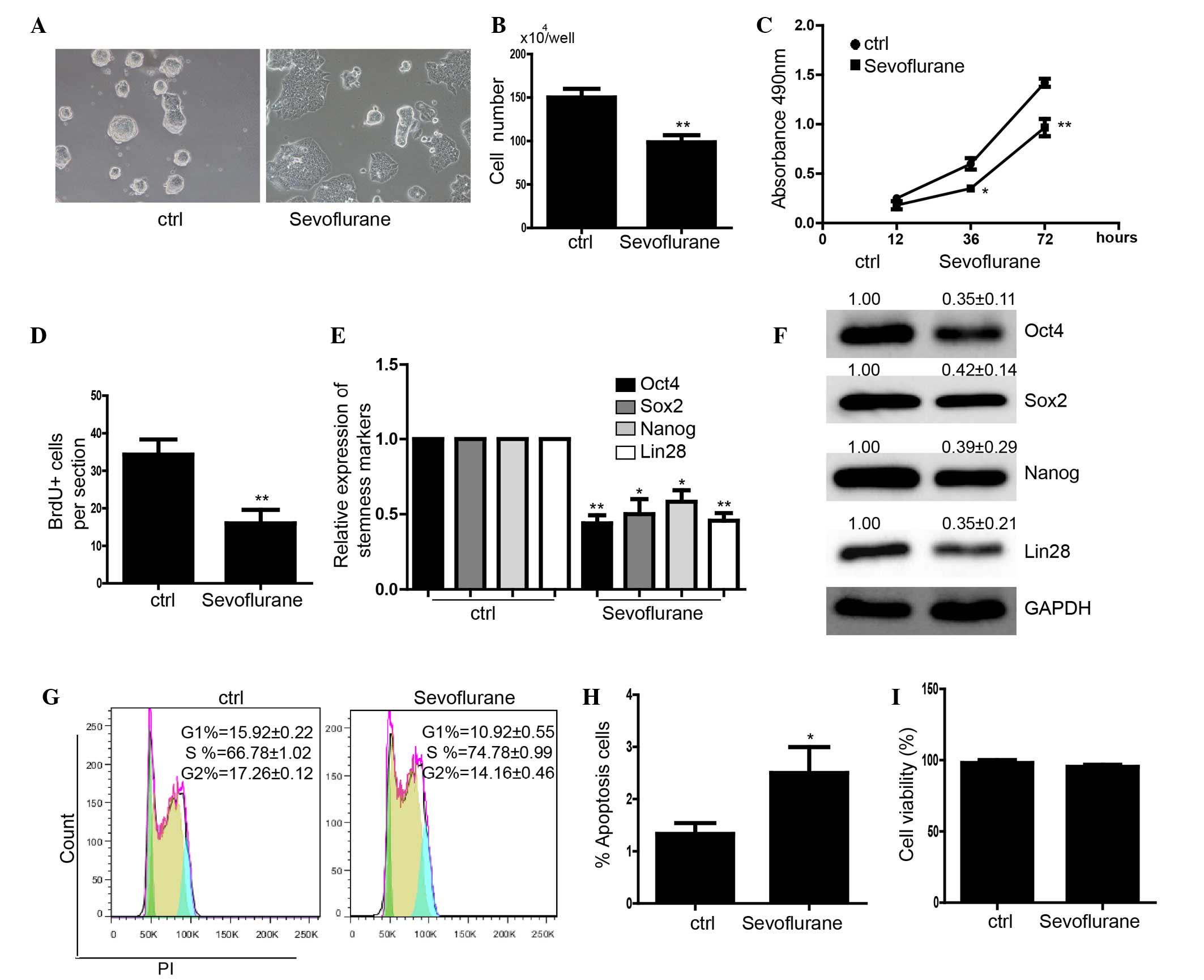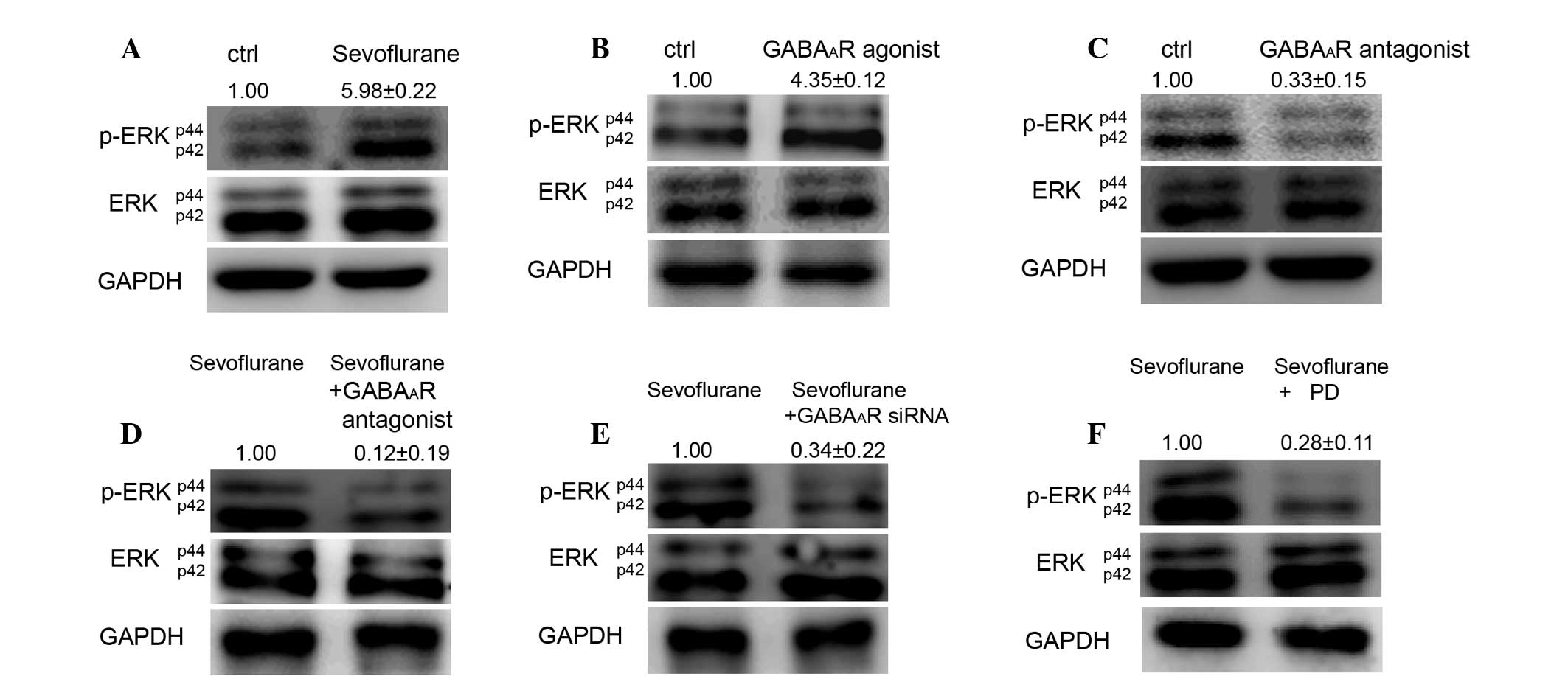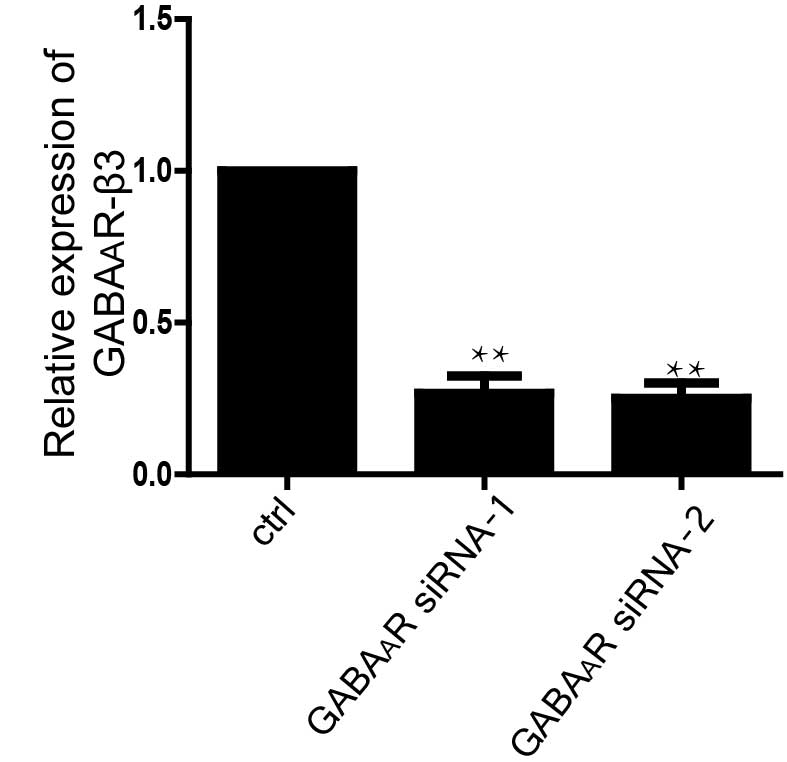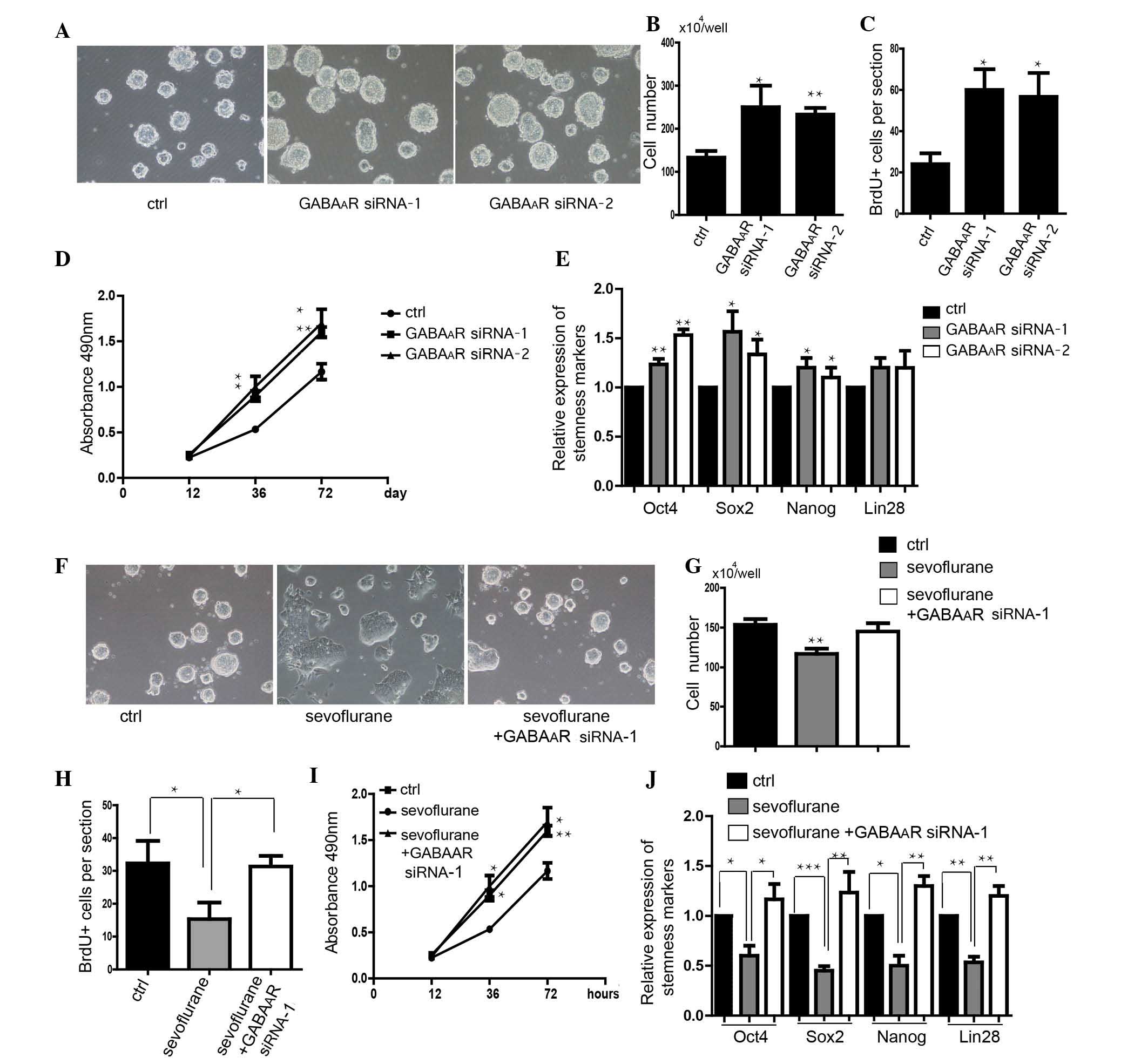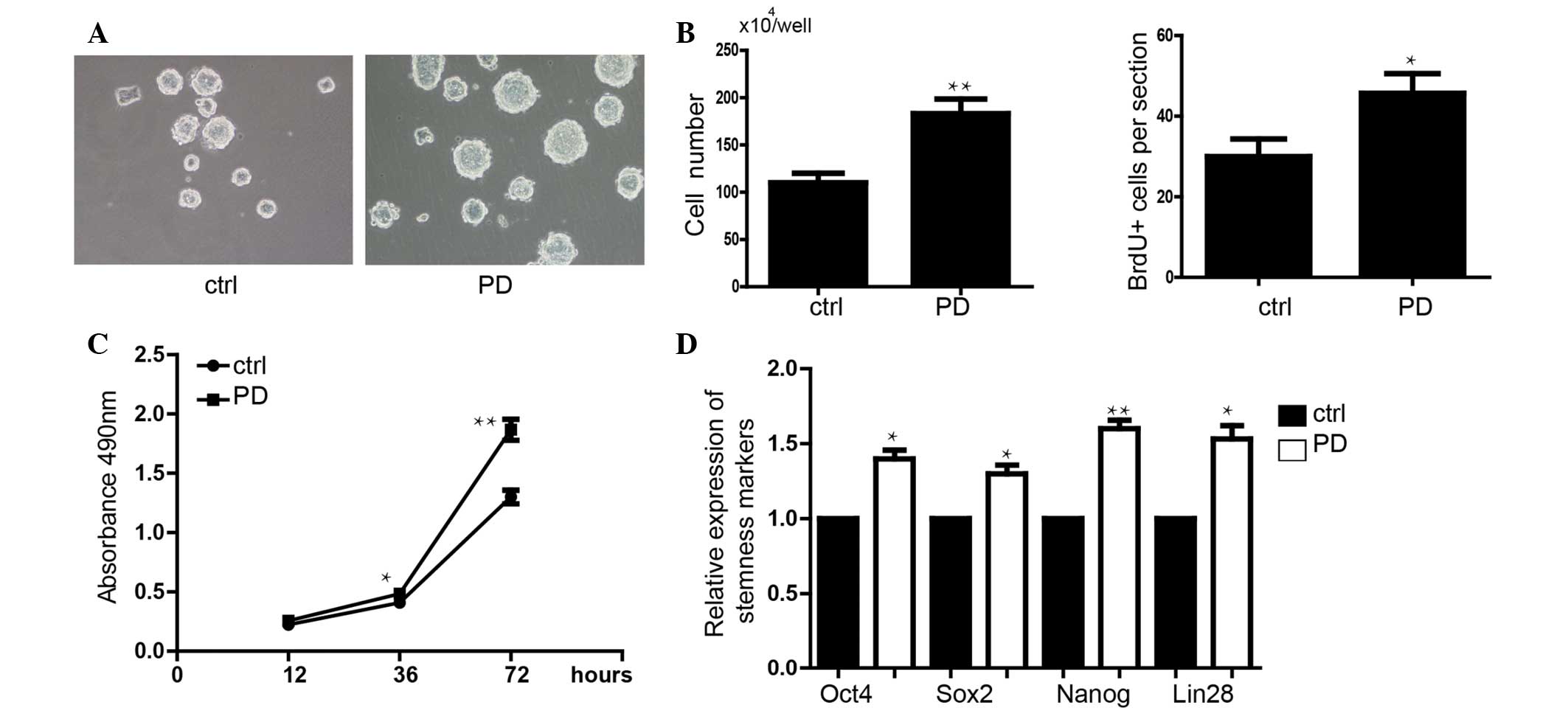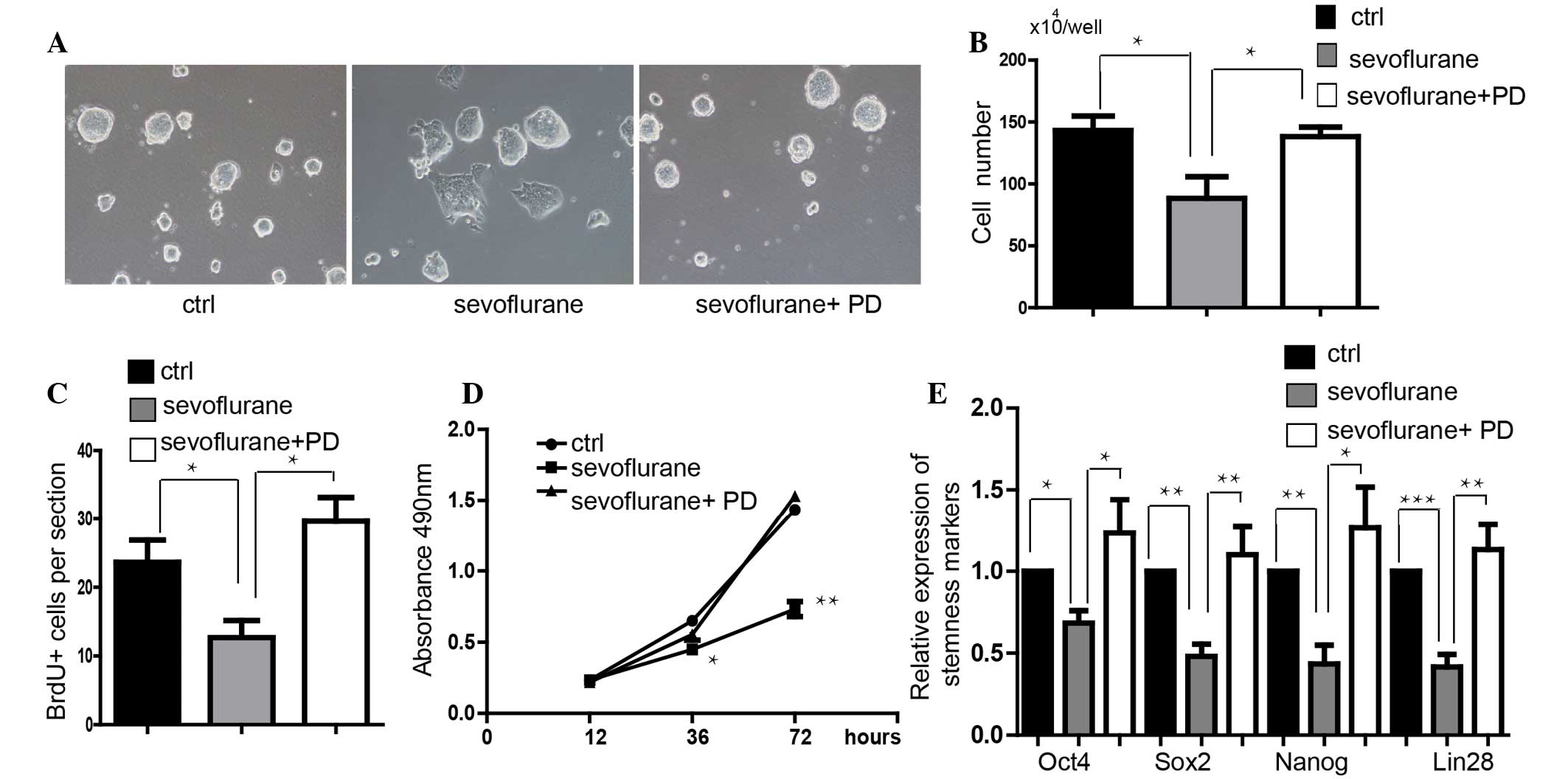Sevoflurane inhibits the self-renewal of mouse embryonic stem cells via the GABAAR-ERK signaling pathway
- Authors:
- Published online on: July 4, 2016 https://doi.org/10.3892/mmr.2016.5466
- Pages: 2119-2126
Abstract
Introduction
Currently, ~2% of pregnant women require non-obstetric surgery (1). In the USA, ~75,000 pregnant women undergo non-obstetric surgery annually (2). A number of these patients require multiple or complicated surgeries and thus, exposure to large amounts of inhaled anesthesia. Certain studies have suggested that the inhalation anesthetics may be harmful. Isoflurane has been reported to repress neuron stem cell self-renewal and influence the differentiation and growth of neural progenitor cells (3,4). Sevoflurane, the most widely used inhaled anesthetic for general anesthesia, is lipophilic and thus readily crosses the placental barrier (5). Sevoflurane was shown to decrease the self-renewal of neuronal stem cells at clinically relevant concentrations in vitro (6). Therefore, sevoflurane-induced embryotoxicity has become a major health issue of interest. However, the mechanism underlying the effects of embryotoxicity on fetus development induced by sevoflurane remains largely unknown.
Embryonic stem (ES) cells are derived from the inner cell mass (ICM) of blastocysts, which is the early-stage preimplantation embryo (7,8). Due to the unlimited self-renewal ability and pluripotency, ES cells are widely used for research into development. ES cell self-renewal properties mean they proliferate rapidly under continued maintenance of pluripotency (9). Certain cell signaling pathways, such as leukemia inhibitory factor (Lif)/Signal transducer and activator of transcription 3 (stat3) and extracellular signal-regulated kinase (ERK), have been reported to regulate the self-renewal and pluripotency of ES cells (8,10–13). These signaling pathways act synergically to regulate self-renewal. Activation of ERK signaling was shown to induce the differentiation of mES cells (14). Lif/stat3 signaling, which maintains the self-renewal ability of mES cells, significantly inhibited the activation of ERK signaling (15). Moreover, inhibition of ERK signaling impairs mouse ES cell self-renewal (16). ERK signaling is important in regulating mES cell self-renewal and pluripotency by acting as a switch. Additionally, γ-aminobutyric acid (GABA) signaling, which is important in neural regulation, has also been reported to be a critical regulator of mES cell self-renewal (17,18). However, the interaction between these signaling pathways that modulate mES cell self-renewal remains largely unknown.
GABA was commonly hypothesized to be the inhibitory neurotransmitter in the central nervous system (CNS); however, studies have demonstrated that GABA signaling regulates physiological and metabolic processes in numerous cell types. GABA signaling can regulate the development of the central nervous system (19,20). GABA signaling can also stimulate hepatocellular carcinoma growth via the GABAA receptor (GABAAR) (21). Studies have demonstrated that midazolam, a GABAAR agonist, can inhibit the proliferation of neural stem cells in vitro (22). Midazolam can also induce cellular apoptosis in human cancer cells (23). Sevoflurane is another GABAAR agonist and it has been reported to induce apoptosis in neural stem cells (24). However, whether sevoflurane can influence the self-renewal of mES cells by GABA signaling remains largely unknown. In the present study, mES cells were treated with 4.1% sevoflurane to detect the potential toxicity of sevoflurane to mES cells and it was determined that sevoflurane could inhibit the self-renewal of mES cells. Knockdown of the GABAAR rescued the effect of sevoflurane on self-renewal. Furthermore, it was demonstrated that sevoflurane upregulated the level of p-ERK by GABAAR. Inhibition of ERK signaling also rescued the sevoflurane-induced inhibition of mES cell self renewal. These results suggested that sevoflurane inhibits the self-renewal of mES cells by regulating the GABAAR-ERK signaling pathway. Thus, the GABAAR-ERK signaling pathway may be a target for preventing the toxicity of inhalation anesthetics to developing fetal brain in the clinic, in pregnant women undergoing non-obstetric surgery under inhalation general anesthesia.
Materials and methods
Cell culture
E14 mES cells, purchased from the Institute of Biochemistry and Cell Biology (SCSP-204; Shanghai, China), were seeded in plates pre-coated with 0.1% gelatin in Dulbecco's modified Eagle's medium (Gibco; Thermo Fisher Scientific, Inc., Waltham, MA, USA) containing 15% fetal bovine serum (FBS; Gibco; Thermo Fisher Scientific, Inc.), glutamine (1:100; Invitrogen), NEAA (1:100; Invitrogen; Thermo Fisher Scientific, Inc.), B-ME (1:550; Invitrogen; Thermo Fisher Scientific, Inc.) and Lif (1:10,000; Invitrogen; Thermo Fisher Scientific, Inc.) at a density of 6×104 cells per well in six-well plates, and cultured at 37°C in a humidified atmosphere containing 5% CO2.
Cell treatment
The sevoflurane group was exposed to 4.1% sevoflurane (Hengrui Pharmaceutical Co., Ltd., Shanghai, China), 5% CO2 and 21% O2, and the control group was exposed to included 5% CO2 and 21% O2 for 6 h, as previously described (25). This concentration of sevoflurane was selected as it is clinically relevant, and has been shown to induce apoptotic cell death and neuroinflammation in H4 human neuroglioma cells and neurons (26,27). A DragerVamos gas analyzer (Drägerwerk AG, Lübeck, Germany) was used to monitor the concentration of CO2, O2 and sevoflurane. In the rescue experiments, cells were treated with 4.1% sevoflurane for 6 h, prior to culture for a further 6 h in normal culture medium. Transfection with small interfering RNA (siRNA) or addition of compounds was then conducted. GABAAR agonist muscimol (50 µM), GABAAR antagonist bicuculline (100 µM) and ERK signaling inhibitor PD0325901 (0.5 µM; all Sigma-Aldrich, St. Louis, MO, USA), were added to mES cells 2 h prior to sevoflurane exposure, respectively.
MTS assay for cell proliferation analysis
According to a previous study, Cell Titer 96® AQueous One Solution Cell Proliferation Assay kit (Promega Corporation, Madison, WI, USA) was used to perform an MTS assay and absorption was detected at 490 nm using a microplate reader as previously described (12).
Transfection of siRNA
siRNA was used for the downregulation of GABAAR-β3. The sequence of siRNA was the same as that in a previous study (18). siRNA (synthesized by Biotend, Shanghai, China) was transfected into cells using the Fugene HD transfection reagent according to the manufacturer's instructions (Roche, Basel, Switzerland).
Reverse transcription-quantitative polymerase chain reaction
Total RNA was extracted using TRIzol reagent (Sigma-Aldrich), and 300 ng was reverse-transcribed using M-MLV Reverse Transcriptase (Promega Corporation). The primers used were described in a previous study (8) and were as follows: Forward: 5′-GGATGCTGTGAGCCAAGG-3′ and reverse: 5′-GAACAAAATGATGAGTGACAGACAG-3′ for octamer-binding transcription factor 4 (Oct4); forward: 5′-CAGGTGTTTGAGGGTAGCTC-3′ and reverse: 5′-CGGTTCATCATGGTACAGTC-3′ for Nanog; forward: 5′-GATCAGCATGTACCTCCCC-3′ and reverse: 5′-CCCTCCCAATTCCCTTGTATC-3′ for SRY (sex determining region Y)-box 2 (Sox2); forward: 5′-GGCATCTGTAAGTGGTTCAACG-3′ and reverse 5′-CCCTCCTTGAGGCTTCGGA-3′ for Lin28; forward: 5′-AATCAAAATCCCTGATCTAACCGA-3′ and reverse: 5′-AAGAGAGAAAAGGTGAATGGAAACA-3′ for GABAAR-β3; and forward, 5′-CTGGGCTACACTGAGCACC-3′ and reverse, 5′-AAGTGGTCGTTGAGGGCAATG-3′ for GAPDH. RT-qPCR was conducted using an Mx3000P system (Stratagene, San Diego, CA, USA). The RT-qPCR included 40-cycles of amplification. Expression of target genes was normalized against endogenous glyceraldehyde 3-phosphate dehydrogenase (GAPDH) using the 2−ΔΔCq method (28).
Western blot analysis
Cells were lysed in sodium dodecyl sulfate (SDS) and protein concentration was measured with a BCA Protein assay kit (Beyotime Institute of Biotechnology, Haimen, China). Cell lysates (50 µg protein) were re-suspended using 5X loading lysis buffer (250 mM Tris-HCl, pH 6.8; 5% DTT, 10% SDS, 0.5% of 0.025 g bromophenol blue and 50% glycerine) and separated with 10% SDS-PAGE gel electrophoresis and transferred to polyvinyldene difluoride membranes (Bio-Rad Laboratories, Inc., Hercules, CA, USA). The membrane was blocked in Tris-buffered saline with Tween 20 (TBST) containing 3% bovine serum albumin (Amresco, LLC, Solon, OH, USA) for 1 h and then incubated with primary antibodies against p-ERK (cat no. ab115617, Abcam, Cambridge, MA, USA), ERK (cat. no. ab17942, Abcam), GAPDH (cat. no. ab181602, Abcam), Sox2 (cat. no. ab79351, Abcam), Oct (cat. no. ab18976, Abcam), Nanog (cat. no. ab80892, Abcam) and Lin28 (cat. no. ab63740, Abcam) at 4°C overnight. Subsequently, the membranes were washed with TBST and incubated with a horseradish peroxidase-conjugated goat anti-rabbit secondary antibody (ab7090) for 1 h at room temperature. Signals were visualized by enhanced chemiluminescence (Thermo Fisher Scientific, Inc.).
5′-bromo-deoxyuridine (BrdU) incorporation analysis
Cells were incubated with 10 µM BrdU (Roche) for 1.5 h, the labeling solution was removed and the cells were washed twice with phosphate-buffered saline (PBS). The cells were fixed in 4% paraformaldehyde (Sigma-Aldrich) for 20 min prior to washing with PBS. The cells were then incubated with HCl for 30 min and this was neutralized with 0.1 M sodium borate buffer for 30 min at room temperature. The cells were washed with PBS and then blocked in PBS containing 10% FBS for 1 h. Anti-BrdU (1:100; Santa Cruz Biotechnology, Inc., Dallas, TX, USA) was incubated with the cells overnight at 4°C, subsequently, the cells were washed three times in PBs and incubated with a secondary fluorescent antibody (1:1,000; Abcam; ab6785) for 1 h. The cell nuclei were stained with DAPI. The number of BrdU-positive cells were counted in at least 5 microscopic fields (Eclipse Ti-S; Nikon Corporation, Tokyo, Japan).
Trypan blue staining
A single cell suspension was prepared in phosphate-buffered saline, and then 0.4% trypan blue solution (Sigma-Aldrich) was added. After 3 min, the total number of viable cells (unstained) and total cells (stained and unstained) was counted under a microscope to determine the cell viability according to the following equation: Cell viability (%) = (viable cells/total cells) × 100.
Cell apoptosis analysis
A total of 1×105 cells were suspended in 500 µl binding buffer. Annexin V-fluorescein isothiocyanate (FITC; 5 µl) was added followed by 5 µl propidium iodide. The mixture was incubated at room temperature for 10 min in the dark. Flow cytometry was conducted to count the percentage of cell in early apoptosis and late stage. Annexin V-FITC Cell Apoptosis Detection kit (Keygentec, Nanjing, China) was used to perform the cell apoptosis analysis.
Statistical analysis
Student's t-test was used for comparing two data sets, and multiple comparisons were compared using two-way analysis of variance using GraphPad Prism 5.0 (GraphPad Software, Inc., La Jolla, CA, USA). P<0.05 was considered to indicate a statistically significant difference. Values are presented as the mean ± standard deviation.
Results
Sevoflurane represses the self-renewal of mES cells
In this study, mES cells were used as a model to investigate the effect of sevoflurane on embryonic development. The mES cells were treated with 4.1% sevoflurane for 6 h as in a previous study (25). The cells were then cultured for another 24 h and it was demonstrated that the morphology of the clones could not be maintained (Fig. 1A). The cell number in the sevoflurane-treated mES group was significantly less than that in the control group (Fig. 1B). The MTS assay demonstrated that the proliferation of mES cells was significantly inhibited by sevoflurane treatment compared with that in control (Fig. 1C). The BrdU+ assay also showed that the mES cells treated with sevoflurane had a lower capacity for proliferation (Fig. 1D). The expression levels of stemness markers Oct4, Sox2, Nanog and Lin28 were also downregulated in the sevoflurane-treated mES cells at the mRNA and protein level (Fig. 1E and F). Cell cycle analysis showed that the cell cycle was arrested at S phase following treatment with sevoflurane (Fig. 1G). Furthermore, an apoptosis assay was conducted using fluorescence-activated cell sorting, which determined that treatment with 4.1% sevoflurane for 6 h induced alight apoptosis over 24 h (Fig. 1H). Trypan blue staining indicated there was no significant cell death (Fig. 1I).
Sevoflurane upregulates the level of p-ERK by GABAAR signalling
In order to identify the mechanism underlying the effect of sevoflurane on mES cells, the mES cells were treated with 4.1% sevoflurane for 6 h. It was determined that sevoflurane increases the level of p-ERK but not the total expression of ERK (Fig. 2A). The GABAAR agonist muscimol (50 µM) also upregulated the level of p-ERK (Fig. 2B). Conversely, GABAAR antagonist bicuculline (100 µM) downregulated the level of p-ERK in mES cells (Fig. 2C). Notably, the GABAAR antagonist and GABAAR siRNA attenuated the sevoflurane-induced activation of ERK (Fig. 2D and E). PD0325901 (0.5 µM), an inhibitor of ERK signaling, also attenuated the sevoflurane-induced activation of ERK (Fig. 2F).
Knockdown of GABAAR-β3 rescues the sevoflurane-induced inhibition of self-renewal in mES cells
The expression level of GABAAR-β3 was downregulated following treatment with GABAAR siRNA (Fig. 3). The number of mES cells with downregulated GABAAR-β3 was shown to be greater than that in control cells (Fig. 4A and B). Knockdown of GABAAR-β3 promoted the proliferation of mES cells (Fig. 4C and D). Downregulation of GABAAR-β3 increased the expression levels of stemness markers, Oct4, Sox2 and Nanog (Fig. 4E). Transfection of GABAAR-β3 siRNA into mES cells rescued the sevoflurane-induced inhibition of self-renewal in mES cells, detected via morphological observation (Fig. 3F). Knockdown of GABAAR-β3, rescued the decrease in cell number caused by sevoflurane (Fig. 4G). Cell proliferation, which can be inhibited by sevoflurane was also rescued by downregulation of GABAAR-β3 (Fig. 4H and I). Knockdown of GABAAR-β3 also rescued the sevoflurane-induced decrease in expression of stemness genes in mES cells (Fig. 4J).
Inhibition of ERK attenuates the sevoflurane-induced inhibition of self-renewal in mES cells
PD0325901 (0.5 µM), an inhibitor of ERK signaling, was shown to promote the proliferation of mES cells (Fig. 5A–D). Additionally, PD0325901 significantly upregulated the expression level of stemness markers Oct4, Sox2, Nanog and Lin28 (Fig. 5E). In order to detect whether the activity of ERK signalinh mediated the function of sevoflurane on suppressing self-renewal, a rescue experiment was conducted. It was demonstrated that addition of PD0325901 blocked sevoflurane-induced inhibition of self-renewal in mES cells via observation of clone morphology (Fig. 6A). Inhibition of ERK signaling also rescued the sevoflurane-induced decrease in cell proliferation (Fig. 6B–D). Furthermore, inhibition of ERK signaling also rescued stemness marker expression, which was significantly down-regulated by sevoflurane (Fig. 6E).
Discussion
Numerous pregnant women are exposed to inhalation anesthetics for non-obstetric surgery (1). Inhalation anesthetics readily cross the placental barrier and thus embryotoxicity is a major concern. Previous studies have demonstrated that inhalation anesthetics repressed the self-renewal of cultured rat neural stem cells and human neural progenitor cells (3,6). However, the mechanism underlying these effects is largely unknown. ES cells derived from the ICM of the blastocyst proliferate rapidly and maintain stemness, which are two critical characteristics of self-renewal. The compromising pluripotency was assured by the infinite and rapid self-renewal (29). In the present study, mES cells were used as an early development model. Treatment with 4.1% sevoflurane (the clinical concentration) for 6 h inhibited the self-renewal of mES cells following further culture. It was shown that sevoflurane repressed the self-renewal of mES cells, which showed destroyed clone morphology with lower expression levels of stemness genes (Nanog, Oct4, Sox2 and Lin28), and slower proliferation at a clinically relevant concentration. These results suggested that sevoflurane is a potential threat to early fetal development due to its toxicity.
A number of general anesthetic agents, including sevoflurane, are GABAAR modulators (30). GABA signaling occurs in numerous cell types and regulates cell proliferation, differentiation, immunomodulation and other physiological processes (31–33). Previous studies showed that GABA is released by mES cells and acts as a trophic factor regulating key developmental processes, including the proliferation of mES cells (7,34). Therefore, excessive or prolonged GABAergic stimulation, such as with ethanol or valproic acid, which like sevoflurane are GABA agonists/modulators, decreases the proliferation of mES cells. As such, it was hypothesized that excessive GABA receptor-mediated excitation produced in mES cells during exposure to sevoflurane may cause decreased proliferation of these cells. Thus, the present study treated the mES cells with 4.1% sevoflurane for 6 h, as described previously (25), and demonstrated that sevoflurane represses the self-renewal of mES cells. The expression level of stemness markers Oct4, Sox2, Nanog and Lin28 was also downregulated. In addition, the activation of GABAAR significantly inhibited stemness maintenance and proliferation, in order to suppress the self-renewal of mES cells on stemness maintenance and proliferation. Inhibition of GABAAR signaling by downregulating the GABAA R rescued the effects of sevoflurane on self-renewal. These results suggested that sevoflurane may act via GABAAR. As GABAAR is a receptor, there must be downstream factors that have direct role in the regulation of self-renewal.
The activation of ERK inhibited the self-renewal of mES cells and promoted differentiation (35). The present study demonstrated that sevoflurane upregulated the level of p-ERK but not the total expression of ERK. Knockdown of the GABAAR rescued the sevoflurane-induced activation of ERK and inhibition of self-renewal in mES cells. Additionally, inhibition of ERK signaling could also rescue the effects of sevoflurane. Therefore, the present data suggest that sevoflurane may repress the self-renewal of mES cells via a GABAAR/ERK signaling dependent mechanism.
In conclusion, sevoflurane inhibited the self-renewal of mES cells. In addition, GABAAR/ERK signaling may be a potential therapeutic target for the prevention of the embryotoxicity of sevoflurane.
References
|
Ní Mhuireachtaigh R and O'Gorman DA: Anesthesia in pregnant patients for nonobstetric surgery. J Clin Anesth. 18:60–66. 2006. View Article : Google Scholar : PubMed/NCBI | |
|
Reitman E and Flood P: Anaesthetic considerations for non-obstetric surgery during pregnancy. Br J Anaesth. 107(suppl 1): i72–i78. 2011. View Article : Google Scholar : PubMed/NCBI | |
|
Culley DJ, Boyd JD, Palanisamy A, Xie Z, Kojima K, Vacanti CA, Tanzi RE and Crosby G: Isoflurane decreases self-renewal capacity of rat cultured neural stem cells. Anesthesiology. 115:754–763. 2011. View Article : Google Scholar : PubMed/NCBI | |
|
Zhao X, Yang Z, Liang G, Wu Z, Peng Y, Joseph DJ, Inan S and Wei H: Dual effects of isoflurane on proliferation, differentiation and survival in human neuroprogenitor cells. Anesthesiology. 118:537–549. 2013. View Article : Google Scholar : PubMed/NCBI | |
|
Lu Y, Wu X, Dong Y, Xu Z, Zhang Y and Xie Z: Anesthetic sevoflurane causes neurotoxicity differently in neonatal naïve and Alzheimer disease transgenic mice. Anesthesiology. 112:1404–1416. 2010. View Article : Google Scholar : PubMed/NCBI | |
|
Zhang Y, Dong Y, Zheng H, Shie V, Wang H, Busscher JJ, Yue Y, Xu Z and Xie Z: Sevoflurane inhibits neurogenesis and the Wnt-catenin signaling pathway in mouse neural progenitor cells. Curr Mol Med. 13:1446–1454. 2013. View Article : Google Scholar : PubMed/NCBI | |
|
Thomson JA, Itskovitz-Eldor J, Shapiro SS, Waknitz MA, Swiergiel JJ, Marshall VS and Jones JM: Embryonic stem cell lines derived from human blastocysts. Science. 282:1145–1147. 1998. View Article : Google Scholar : PubMed/NCBI | |
|
Niwa H, Burdon T, Chambers I and Smith A: Self-renewal of pluripotent embryonic stem cells is mediated via activation of STAT3. Genes Dev. 12:2048–2060. 1998. View Article : Google Scholar : PubMed/NCBI | |
|
Nagaoka MKU, Yuasa S, Hattori F, Chen H, Tanaka T, Okabe M, Fukuda K and Akaike T: E-cadherin-coated plates maintain pluripotent ES cells without colony formation. PLoS One. 1:e152006. View Article : Google Scholar : PubMed/NCBI | |
|
Matsuda T, Nakamura T, Nakao K, Arai T, Katsuki M, Heike T and Yokota T: STAT3 activation is sufficient to maintain an undifferentiated state of mouse embryonic stem cells. EMBO J. 18:4261–4269. 1999. View Article : Google Scholar : PubMed/NCBI | |
|
Ogawa K, Saito A, Matsui1 H, Suzuki H, Ohtsuka S, Shimosato D, Morishita Y, Watabe T, Niwa H and Miyazono K: Activin-nodal signaling is involved in propagation of mouse embryonic stem cells. J Cell Sci. 120:55–65. 2007. View Article : Google Scholar | |
|
Liu Q, Wang G, Chen Y, Li G, Yang D and Kang J: A miR-590/ACVR2a/Rad51B axis regulates DNA damage repair during mES cell proliferation. Stem Cell Reports. 3:1103–1117. 2014. View Article : Google Scholar : PubMed/NCBI | |
|
Kunath T, Saba-El-Leil MK, Almousailleakh M, Wray J, Meloche S and Smith A: FGF stimulation of the Erk1/2 signalling cascade triggers transition of pluripotent embryonic stem cells from self-renewal to lineage commitment. Development. 134:2895–2902. 2007. View Article : Google Scholar : PubMed/NCBI | |
|
Li L, Sun L, Gao F, Jiang J, Yang Y, Li C, Gu J, Wei Z, Yang A, Lu R, et al: Stk40 links the pluripotency factor Oct4 to the Erk/MAPK pathway and controls extraembryonic endoderm differentiation. Proc Natl Acad Sci USA. 107:1402–1407. 2010. View Article : Google Scholar : PubMed/NCBI | |
|
Liu JW, Hsu YC, Kao CY, Su HL and Chiu IM: Leukemia inhibitory factor-induced Stat3 signaling suppresses fibroblast growth factor 1-induced Erk1/2 activation to inhibit the downstream differentiation in mouse embryonic stem cells. Stem Cells Dev. 22:1190–1197. 2013. View Article : Google Scholar | |
|
Chen H, Guo R, Zhang Q, Guo H, Yang M, Wu Z, Gao S, Liu L and Chen L: Erk signaling is indispensable for genomic stability and self-renewal of mouse embryonic stem cells. Proc Natl Acad Sci USA. 112:E5936–E5943. 2015. View Article : Google Scholar : PubMed/NCBI | |
|
Hjerling-Leffler J, Marmigère F, Heglind M, Cederberg A, Koltzenburg M, Enerbäck S and Ernfors P: The boundary cap: A source of neural crest stem cells that generate multiple sensory neuron subtypes. Development. 132:2623–2632. 2005. View Article : Google Scholar : PubMed/NCBI | |
|
Andäng M, Hjerling-Leffler J, Moliner A, Lundgren TK, Castelo-Branco G, Nanou E, Pozas E, Bryja V, Halliez S, Nishimaru H, et al: Histone H2AX-dependent GABA (A) receptor regulation of stem cell proliferation. Nature. 451:460–464. 2008. View Article : Google Scholar | |
|
Behar TN, Schaffner AE, Scott CA, Greene CL and Barker JL: GABA receptor antagonists modulate postmitotic cell migration in slice cultures of embryonic rat cortex. Cereb Cortex. 10:899–909. 2000. View Article : Google Scholar : PubMed/NCBI | |
|
Meier J, Akyeli J, Kirischuk S and Grantyn R: GABA (A) receptor activity and PKC control inhibitory synaptogenesis in CNS tissue slices. Mol Cell Neurosci. 23:600–613. 2003. View Article : Google Scholar : PubMed/NCBI | |
|
Li YH, Liu Y, Li YD, Liu YH, Li F, Ju Q, Xie PL and Li GC: GABA stimulates human hepatocellular carcinoma growth through overexpressed GABAA receptor theta subunit. World J Gastroenterol. 18:2704–2711. 2012. View Article : Google Scholar : PubMed/NCBI | |
|
Zhao S, Zhu Y, Xue R, Li Y, Lu H and Mi W: Effect of midazolam on the proliferation of neural stem cells isolated from rat hippocampus. Neural Regen Res. 7:1475–1482. 2012.PubMed/NCBI | |
|
Mishra SK, Kang JH, Lee CW, Oh SH, Ryu JS, Bae YS and Kim HM: Midazolam induces cellular apoptosis in human cancer cells and inhibits tumor growth in xenograft mice. Mol Cells. 36:219–226. 2013. View Article : Google Scholar : PubMed/NCBI | |
|
Qiu J, Shi P, Mao W, Zhao Y, Liu W and Wang Y: Effect of apoptosis in neural stem cells treated with sevoflurane. BMC Anesthesiol. 7:252015. View Article : Google Scholar | |
|
Zhang L, Zhang J, Yang L, Dong Y, Zhang Y and Xie Z: Isoflurane and sevoflurane increase interleukin-6 levels through the nuclear factor-kappa B pathway in neuroglioma cells. Br J Anaesth. 110(Suppl 1): i82–i91. 2013. View Article : Google Scholar : PubMed/NCBI | |
|
Shen X, Dong Y, Xu Z, Wang H, Miao C, Soriano SG, Sun D, Baxter MG, Zhang Y and Xie Z: Selective anesthesia-induced neuroinflammation in developing mouse brain and cognitive impairment. Anesthesiology. 118:502–515. 2013. View Article : Google Scholar : PubMed/NCBI | |
|
Zheng H, Dong Y, Xu Z, Crosby G, Culley DJ, Zhang Y and Xie Z: Sevoflurane anesthesia in pregnant mice induces neurotoxicity in fetal and offspring mice. Anesthesiology. 118:516–526. 2013. View Article : Google Scholar : PubMed/NCBI | |
|
Livak KJ and Schmittgen TD: Analysis of relative gene expression data using real-time quantitative PCR and the 2(−Delta Delta C(T)) Method. Methods. 25:402–408. 2001. View Article : Google Scholar | |
|
Wang Y, Baskerville S, Shenoy A, Babiarz JE, Baehner L and Blelloch R: Embryonic stem cell-specific microRNAs regulate the G1-S transition and promote rapid proliferation. Nat Genet. 40:1478–1483. 2008. View Article : Google Scholar : PubMed/NCBI | |
|
Maher BJ and LoTurco JJ: Stop and go GABA. Nat Neurosci. 12:817–818. 2009. View Article : Google Scholar : PubMed/NCBI | |
|
Gladkevich A, Korf J, Hakobyan VP and Melkonyan KV: The peripheral GABAergic system as a target in endocrine disorders. Auton Neurosci. 124:1–8. 2006. View Article : Google Scholar | |
|
Jin Z, Mendu SK and Birnir B: GABA is an effective immunomodulatory molecule. Amino Acids. 45:87–94. 2013. View Article : Google Scholar : | |
|
Tian J, Dang H, Chen Z, Guan A, Jin Y, Atkinson MA and Kaufman DL: γ-Aminobutyric acid regulates both the survival and replication of human β-cells. Diabetes. 62:3760–3765. 2013. View Article : Google Scholar : PubMed/NCBI | |
|
LoTurco JJ, Owens DF, Heath MJ, Davis MB and Kriegstein AR: GABA and glutamate depolarize cortical progenitor cells and inhibit DNA synthesis. Neuron. 15:1287–1298. 1995. View Article : Google Scholar : PubMed/NCBI | |
|
Liu Y, Liu Q, Jia W, Chen J, Wang J, Ye D, Guo X, Chen W, Li G, Wang G, et al: MicroRNA-200a regulates Grb2 and suppresses differentiation of mouse embryonic stem cells into endoderm and mesoderm. PLoS One. 8:e689902013. View Article : Google Scholar : PubMed/NCBI |



